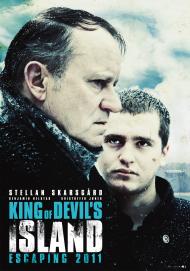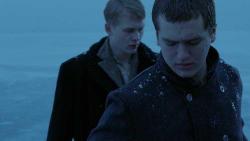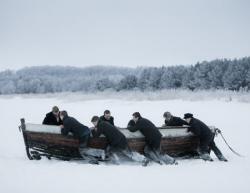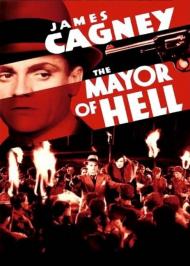Movie Review
King of Devil's Island

US Release Date: 10-21-2011
Directed by: Marius Holst
Starring▸▾
- Stellan Skarsgard, as
- Hakon/ The Governor
- Benjamin Helstad, as
- Erling "C19"
- Trond Nilssen, as
- Olav "C1"
- Kristoffer Joner, as
- Braaten
- Ellen Dorrit Petersen, as
- Astrid
- Magnus Langlete as
- Ivar "C5"
![3.75 star[s] out of 4](http://www.threemoviebuffs.com/static/images/global/featured_gold_stars.png)

Trond Nilssen and Benjamin Helstad in King of Devil's Island.
King of Devil's Island (Kongen av Bastøy) is a 2010 Norwegian film from director Marius Holst. It tells a fictionalized version of the events of a real life rebellion among the youths of the Bastoy Reform School (located on Norway's Bastoy Island) in the winter of 1915. The school/prison was notorious for its brutal treatment of its inmates, including hard labor, beatings and solitary confinements that wreaked psychological damage on many of the boys unlucky enough to be sentenced there.
The movie opens with the arrival of two new prisoners. One, named Erling, quickly becomes one of the toughest kids in the prison while the other, named Ivar, is a slow witted, timid boy. Erling becomes best friends with the leader of the house in which they are assigned, an intelligent young man named Olav. The house they are assigned to is called “C” and the boys are given a number. None of them are called by their names by any guards or teachers while they are serving their time, they are simply known as “C1, C2, C3 etc. Olav is Cl, Erling C19, and Ivar is C5.
Erling attempts to run away early on by breaking into the boathouse and rowing across to the mainland. He is apprehended and brought back in chains. Olav, who is due to be released any day, pleads with Erling to wait until he is gone before making another attempt. Erling is illiterate and Olav agrees to write a letter for him. The letter, which Erling says is for his girlfriend back home, is about Erling's adventures aboard a whaling boat before he was sent to Bastoy.
It comes out that one of the teachers has been molesting Ivar. They go to the Governor of the Island with this information but he refuses to listen. When Ivar drowns himself the Governor finally decides to get rid of the molesting teacher, but the teacher blackmails the Governor to keep his job. This causes Olav to lose it. On the day he is set to be released he attacks the molesting teacher and all hell breaks loose.
The boys run amok and take over the island. They allow the Governor and other teachers to safely leave even knowing that before long the authorities will return in force to retake the island. After such brutal treatment you will find yourself cheering for these boys, many of whom are there simply because their families could no longer care for them. A ship full of Norwegian soldiers soon arrives on the frozen shore and the story heads for its conclusion.
The cast of young boys is very good with Benjamin Helstad and Trond Nilssen both giving excellent performances as Erling and Olav respectively. The most famous face in the movie is Stellan Skarsgård as the despicable Governor. He has appeared in such big budget Hollywood flicks as two of The Pirates of the Caribbean movies, Thor and The Avengers and many other movies.
The cinematography of the wintry island setting is quite stunning but it is the emotional impact of the ending that really packs a wallop. It affected me more than anything I've seen in a long time. I highly recommend this riveting movie based on factual events.
![3.5 star[s] out of 4](http://www.threemoviebuffs.com/static/images/global/featured_gold_stars.png)

King of Devil's Island
One of the things I enjoy about films made in northern Europe is that winter scenes are, more often than not, filmed outside. Hollywood too often uses sound stages that are far too obvious. As Patrick wrote, the cinematography here is beautiful and the landscape plays wonderfully into the story. One of the most stunning visuals is when the boys are trying to push the boat into the water, when they hear a sound. They look to the sea where out of the frozen mist a ship draws near. Not only is that scene visually stunning, but the emotion of that moment is not unlike the final scene of Lord of the Flies.
Another favorite scene of mine comes early on when Erling challenges "C" house's current alpha male. While in the wash room, the current resident bad ass harasses Erling by continuously standing in front of every wash basin Erling attempts to use. Erling turns toward the door as if to leave, but instead closes the door so that he may hit the boy in private.
In 1915, the sexual abuse of boys was something not discussed as openingly as it is today. Look at the scene where Olav tells the governor about the abuse. He does not even know the words to describe it. Thanks to television talk shows and news stories, it has come out of the closet. Look to the Jerry Sandusky case. As recently as this past year a man sexually abused boys with the knowledge that the act brought such shame to the boys that they would never tell. Joe Paterno was crucified by the media for not reporting hearsay. I certainly do not condone his lack of actions, but must point out that he was born in 1926 and raised in a world where such things were kept very, very private.
The Governor at the island does not take a strong hand against the perpetrator but he does make a gesture. The acts in question were of such a sensitive nature that the Governor was unsure of how to react. Does he trust the words of juvenile delinquents or a long term employee. Again, let me reiterate, I do not defend the actions of the adults in this film, but want to point out how hard it must have been to deal with a subject that 100 years later is still struggling to lose its stigma.
As Patrick wrote, the ending is quite moving. We want very much to see Erling and Olav escape. Another stirring moment is when Olav is about to leave but instead attacks the abuser. If only the rest of the film carried as much emotion as those scenes. A couple of repetitive scenes could have been trimmed or cut altogether in order to quicken a pace that occasionally seems to be taking its time.
Bastoy Reformatory was built in 1900. The rebellion depicted in this film did nothing to end the abuse. It went on until 1953 when the Ministry of Social Affairs took control of the prison. The school closed in 1970 but reopened in 1982. Ironically, the current prison on Bastoy Island,is now noted for its liberal, indulgent treatment of its inmates who live in cottages, have access to a sauna, tennis courts and horseback riding.
Photos © Copyright Film Movement (2011)

